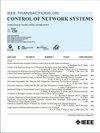Online and Offline Dynamic Influence Maximization Games Over Social Networks
IF 4
3区 计算机科学
Q2 AUTOMATION & CONTROL SYSTEMS
引用次数: 0
Abstract
In this work, we consider dynamic influence maximization games over social networks with multiple players (influencers). At the beginning of each campaign opportunity, individuals' opinion dynamics take independent and identically distributed realizations based on an arbitrary distribution. Upon observing the realizations, influencers allocate some of their budgets to affect their opinion dynamics. Then, individuals' opinion dynamics evolve according to the well-known DeGroot model. In the end, influencers collect their reward based on the final opinion dynamics. Each influencer's goal is to maximize their own reward subject to their limited total budget rate constraints, leading to a dynamic game problem. We first consider the基于社交网络的在线和离线动态影响最大化游戏
在这项工作中,我们考虑了具有多个玩家(影响者)的社交网络上的动态影响力最大化游戏。在每个竞选机会的开始,个人的意见动态采取基于任意分布的独立和相同分布的实现。在观察到实现之后,有影响力的人会分配一些预算来影响他们的意见动态。然后,根据著名的DeGroot模型,个人的意见动态演变。最后,有影响力的人根据最终的意见动态收集他们的奖励。每个影响者的目标都是在有限的总预算率约束下最大化自己的奖励,这导致了一个动态博弈问题。我们首先考虑单个影响者优化问题的离线和在线版本,其中意见动态和活动持续时间是已知或未知的先验。然后,我们考虑了离线和在线设置中具有多个影响者的游戏配方。对于离线情况,我们证明了动态博弈中存在唯一的纳什均衡策略,并给出了其计算方法。对于在线设置和两个影响者,我们表明,如果每个影响者应用为单个影响者最大化问题提出的相同的无后悔在线算法,它们收敛到$\epsilon$ -纳什均衡策略集,其中$\epsilon =\mathcal {O}(1/\sqrt{K})$与活动次数的平均比例成反比$K$考虑到影响者的平均效用。此外,我们将这一结果推广到对信息结构有更严格要求的任何有限数量的影响者。
本文章由计算机程序翻译,如有差异,请以英文原文为准。
求助全文
约1分钟内获得全文
求助全文
来源期刊

IEEE Transactions on Control of Network Systems
Mathematics-Control and Optimization
CiteScore
7.80
自引率
7.10%
发文量
169
期刊介绍:
The IEEE Transactions on Control of Network Systems is committed to the timely publication of high-impact papers at the intersection of control systems and network science. In particular, the journal addresses research on the analysis, design and implementation of networked control systems, as well as control over networks. Relevant work includes the full spectrum from basic research on control systems to the design of engineering solutions for automatic control of, and over, networks. The topics covered by this journal include: Coordinated control and estimation over networks, Control and computation over sensor networks, Control under communication constraints, Control and performance analysis issues that arise in the dynamics of networks used in application areas such as communications, computers, transportation, manufacturing, Web ranking and aggregation, social networks, biology, power systems, economics, Synchronization of activities across a controlled network, Stability analysis of controlled networks, Analysis of networks as hybrid dynamical systems.
 求助内容:
求助内容: 应助结果提醒方式:
应助结果提醒方式:


